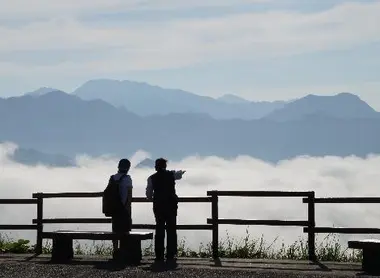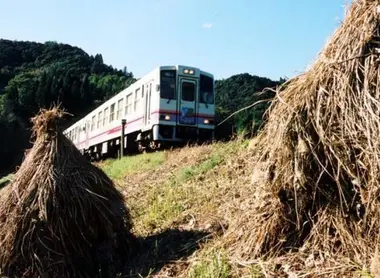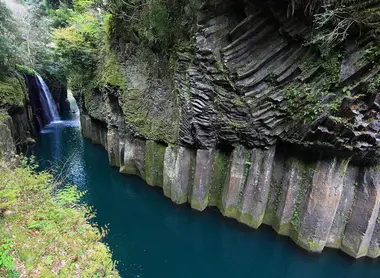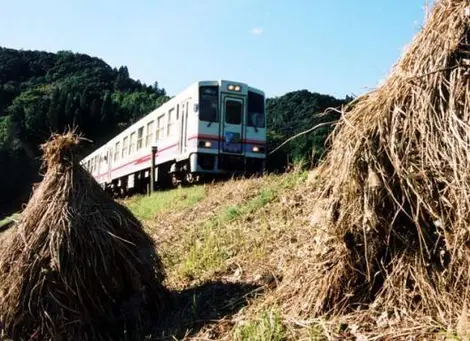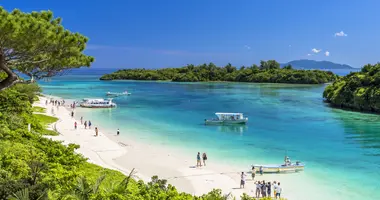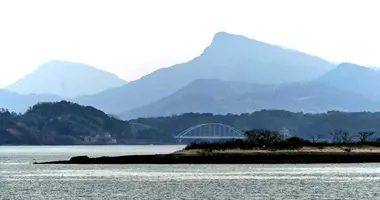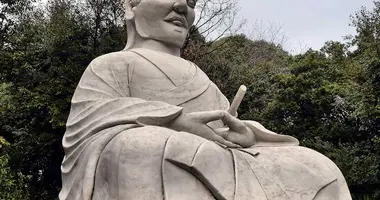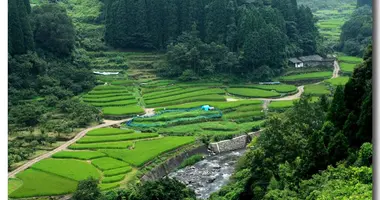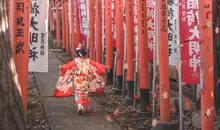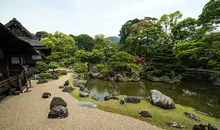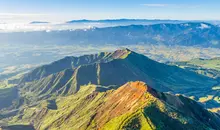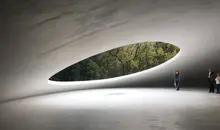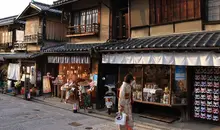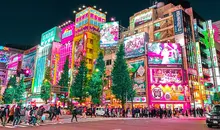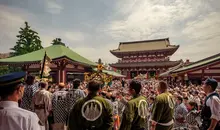Takachiho Jinja Kumamoto
- Published on : 10/06/2016
- by : G.L.
- Youtube
Spiritual and Natural
Takachiho Jinja Shrine, located in Kumamoto Prefecture on the island of Kyushu, is one of Japan's most revered sacred places. Founded some 1,900 years ago, the shrine is deeply rooted in Japanese mythology and plays a major role in the country's spiritual heritage. Visitors are immediately captivated by the majesty of the centuries-old cedars surrounding the pavilions, and by the mystical atmosphere emanating from this place steeped in history. The shrine is particularly famous for its nightly performances of kagura dance, considered to be one of Japan's oldest forms of sacred theater. For travellers exploring the Kumamoto region, Takachiho offers a unique experience combining spectacular nature and authentic cultural immersion.
History and spiritual significance of Takachiho Jinja Shrine
Takachiho-jinja 高千穂神社 was founded almost 1900 years ago, making it one of Japan's oldest Shinto shrines. Its importance in Japanese spiritual history is considerable: it is home to three generations of deities, including Ninigi no Mikoto, the grandson of Amaterasu Omikami (the sun goddess) and the great-grandfather of Emperor Jimmu, considered Japan's first emperor. This direct lineage to the imperial family gives the shrine a particularly revered status.
Located in downtown Takachiho, the shrine is distinguished by its sober, natural architectural style. Unlike many Japanese shrines painted bright red, Takachiho-jinja has a more earthy appearance that blends harmoniously with its natural surroundings. In fact, its main hall and storage room are listed as important cultural assets of Japan. The Takachiho region was once home to over 500 shrines, but Takachiho-jinja remains the largest and most visited of these.
Within the shrine, visitors can admire two large cedar trees connected by their roots, a powerful symbol of union. According to local legend, walking around these trees hand-in-hand with a loved one would bring wealth and prosperity to the couple's descendants. This type of belief illustrates how the shrine remains a living place of tradition and spiritual practice, far beyond its mere historical interest.
Kagura: an ancestral tradition worth discovering
Kagura (神楽) is one of Japan's oldest forms of artistic and religious expression. Its name literally means "entertainment of the deities", underscoring its primary function: to honor the kami (gods) through dance and music. In Takachiho, this tradition takes on a special dimension under the name of yokagura (夜神楽), or "nocturnal kagura", as performances traditionally take place at night.
Legend has it that the kagura was born directly out of one of the most famous episodes in Japanese mythology: the one in which the goddess Amaterasu, having taken refuge in a cave following an argument with her brother Susanoo, plunged the world into darkness. To lure her out of hiding, the goddess Ame-no-Uzume performed an ecstatic dance that made the other deities laugh. Intrigued by these bursts of joy, Amaterasu emerged from her cave, bringing light back into the world. This Uzume dance is considered to be the origin of kagura.
At Takachiho-jinja, the complete version of the yokagura features thirty-three different tableaux recounting episodes from Japanese mythology. This complete version is presented from mid-November to early February, in all-night performances from 9 p.m. to 6 a.m.! However, for visitors during the rest of the year, the shrine offers a condensed one-hour version every evening at 8pm, featuring four main dances:
- Tajikara-o no mai: the search for the hidden divinity
- Uzume no mai: the call to the divinity to come out of the cave
- Totori no mai: the opening of the Amano-iwato cave
- Goshintai no mai: the representation of two gods forming the state
The dancers wear traditional masks and colorful long-sleeved costumes, which play an essential role in the choreography. Accompanied by three traditional instruments - the flute (fue), drum (taiko) and hand cymbals (chappa) - they perform precise, symbolic movements that have hardly changed for centuries. The show currently costs ¥500, although some sources now quote a rate of ¥700, which is still very affordable for such an authentic cultural experience.
How to get to the shrine from Kumamoto and Takachiho
Access to the Takachiho-jinja shrine varies depending on whether you're starting from Kumamoto or are already in the small town of Takachiho.
If you're starting from Kumamoto, you should know that Takachiho is around 140 kilometers away, or around 2h30 to 3h drive. Here are the main options:
- By bus: Take the "Takachiho-go" highway bus from Kumamoto station. The journey takes around 4 hours and costs around 4110 yen. Please note that there are only two connections per day, so check the timetable well in advance.
- By rental car: This is the most flexible and practical option for exploring the region. From Kumamoto, drive mainly along National Road 218 in a northeasterly direction.
Once in Takachiho, the shrine is easy to reach:
- On foot: From the Takachiho bus station, it's about a 10-15 minute walk to the shrine. Just walk down the main downtown street.
- By shuttle bus: If you're staying at a Takachiho hotel or ryokan, many offer free shuttle buses to take you to the shrine, especially for evening kagura performances.
It's important to note that Takachiho hasn't been served by train since 2005, when a typhoon destroyed railway bridges that were never rebuilt. Public transport is therefore limited, which is why car rental is often recommended when visiting this region of Kyushu. If you'd like to explore the surrounding area during your stay, you can also rent electric bicycles (300 yen per hour or 1,500 yen per day) in front of the Takachiho bus station.
Discovering the shrine: points of interest and special features
The Takachiho-jinja shrine offers an immersive experience in traditional Japanese spirituality. Upon entering, visitors are greeted by the serene atmosphere created by the majestic, century-old cedar trees that frame the site. Unlike many brightly-colored Japanese shrines, Takachiho-jinja is distinguished by its natural, earth-toned pavilions, which blend perfectly into their forest surroundings.
One of the shrine's most remarkable landmarks is the pair of twin cedars linked by their roots. These "paired cedars" (meoto sugi) are considered a powerful symbol of union and harmony. According to local tradition, walking around these trees three times hand-in-hand with your partner will ensure prosperity and happiness for future generations. This belief makes the shrine a popular spot for couples and families.
The shrine's main hall (honden) houses the tutelary deities, including Ninigi no Mikoto, grandson of the sun goddess Amaterasu. This building, together with the repository of sacred treasures, is classified as an important cultural asset of Japan. Their sober yet refined architecture bears witness to the traditional approach of Shintoism, which values simplicity and harmony with nature.
For a complete experience, we recommend visiting the shrine at two different times: during the day to appreciate the beauty of the site and its peaceful atmosphere, then in the evening to attend a kagura performance. Entrance to the shrine is free during the day (only the kagura performance is chargeable), so you can take your time exploring the various pavilions and soaking up the sacred atmosphere.
Takachiho Gorge: the perfect complement to a visit to the shrine
Just a few kilometers from the Takachiho-jinja shrine are the spectacular Takachiho Gorge (高千穂峡, Takachiho-kyō), a natural site that perfectly complements the spiritual dimension of the shrine. These impressive gorges were formed around 100,000 years ago by the rapid cooling of lava flows from Mount Aso, creating columnar basalt formations that can reach up to 80 meters in height.
The striking emerald-green Gokase River meanders through the depths of these gorges, providing a spectacular contrast to the dark rock faces. The highlight of this visit is undoubtedly the Manai waterfall (真名井の滝), which cascades majestically 17 metres into the river. One of Japan's 100 most beautiful waterfalls, this waterfall often creates rainbows in the surrounding mist, adding to the mystical beauty of the place.
To explore the gorge, visitors have two main options:
- A boat trip (2,000 yen for 30 minutes), which allows you to sail close to the rock walls and admire the waterfall from a unique angle. This activity is very popular, especially in high season, and it is advisable to book in advance or arrive early in the morning.
- A one-kilometre hiking trail runs along the edge of the gorge, offering several impressive views of the river below and the rock formations. The paved path is accessible to all and offers spectacular photo opportunities.
For visitors interested in Japanese mythology, it's worth noting that this gorge is also linked to the legend of Amaterasu. Indeed, it was not far from here, in the Amano Iwato cave, that the sun goddess took refuge after her quarrel with her brother, plunging the world into darkness. This connection between the natural landscape and Japan's founding myths reinforces the mystical aura that surrounds the entire Takachiho region.
Organize a day trip to Takachiho from Kumamoto
A day trip to Takachiho from Kumamoto is an ambitious project, but one that can be achieved with the right planning. Here's a typical itinerary to optimize your visit:
Early departure from Kumamoto: To make the most of your day, it's essential to leave early, ideally around 7.00-7.30 am. If you opt for the bus, the first departure is usually around 8am from Kumamoto station. By car, allow around 2h30-3h for the journey.
Arrival in Takachiho (around 10.30-11am): Start with a visit to Takachiho Gorge. If you arrive early enough, you may be able to take a boat trip (30 minutes) to admire the Manai waterfall and basalt rock formations. Alternatively, take the trail along the gorge to enjoy the different viewpoints.
Lunch (approx. 12.30-1 p.m.): Take a lunch break to sample local specialties such as Takachiho beef, renowned for its tenderness, or kyôkoku dango, sweet rice dumplings. The Nagashi somen Chiho-no-ie restaurant near the gorge offers a unique culinary experience, with somen noodles sliding down bamboo channels.
Visit the Amano Iwato shrine (around 2 p.m.): This shrine is linked to the legend of Amaterasu and houses the famous cave where the goddess is said to have hidden. Nearby, explore the Amano Yasukawara cave where, according to tradition, the other deities gathered to devise a plan to bring Amaterasu out of hiding.
Takachiho-jinja shrine (around 4 p.m.): Finish your tour with a visit to Takachiho's main shrine. Explore the various pavilions, admire the twin cedars and soak up the spiritual atmosphere.
If your schedule allows, you could also add a short train ride on theAmaterasu Railway, an old railroad line converted into a tourist attraction offering spectacular views of the Takachiho Bridge, 105 meters above the river.
If you wish to attend a kagura performance (highly recommended), you'll need to extend your stay into the evening, or even stay overnight. The show starts at 8pm and lasts about an hour. In this case, remember to book accommodation in advance, as options are limited in this small town.
Practical advice: best time to visit, accommodation and budget
To make the most of your visit to Takachiho Jinja and the surrounding area, here are a few practical tips to help you optimize your experience.
Best time to visit:
- Spring (April-May) offers mild temperatures and lush vegetation, ideal for photos.
- Autumn (October-November) is particularly recommended, with pleasant temperatures and spectacular autumn colors that enhance the gorges and sanctuaries. This is also the period when you can observe the "sea of clouds" phenomenon from the Kunimigaoka observation point.
- Avoid the rainy season (June-July), as boat excursions are often suspended due to high water levels, and the risk of landslides increases.
- For folklore fans, the period from mid-November to early February is ideal for attending full yokagura performances, which last all night.
Accommodation options:
- Ryokans (traditional inns) offer the most authentic experience. Hana Ryokan Iwatoya or Ryokan Shinsen are particularly recommended, with rates from 10,000 yen per person including traditional dinner and breakfast.
- For more modest budgets, minshuku (guest houses) are available from 6,000 yen, such as Guest House Iwato, which offers rooms in a traditional Japanese house.
- The local youth hostel offers beds from 4,500 yen for thrifty travelers.
A major advantage of staying locally is that most accommodations offer free shuttles to kagura performances in the evening, saving you the hassle of looking for transport after the show.
Budget:
- Transportation: Kumamoto-Takachiho bus (4,110 yen round trip), bike rental in Takachiho (1,500 yen/day)
- Attractions: Shrine entrance (free), kagura show (500-700 yen), boat trip in the gorge (2,000 yen)
- Meals: Allow around 1,000-1,500 yen for a meal at a local restaurant such as Nagashi somen Chiho-no-ie, or to sample local specialties such as Takachiho beef
- Souvenirs: Shrine amulets (omamori) (500-1,000 yen) make excellent souvenirs to take home
For the full experience, allow at least a day and a half at Takachiho. Although the main sites can be visited in a day, the relatively short opening hours (until 5 p.m. for most attractions) and the interest of attending an evening kagura performance more than justify a longer stay. What's more, the natural beauty of the gorges deserves to be appreciated unhurriedly, ideally at sunrise or sunset when the light magnifies the rock formations.
Address, timetable & access
Address
Access
Bus from Kumamoto, Fukuoka or Aso city.
By train from Nobeoka station.Website
http://takachiho-kanko.info/en/
